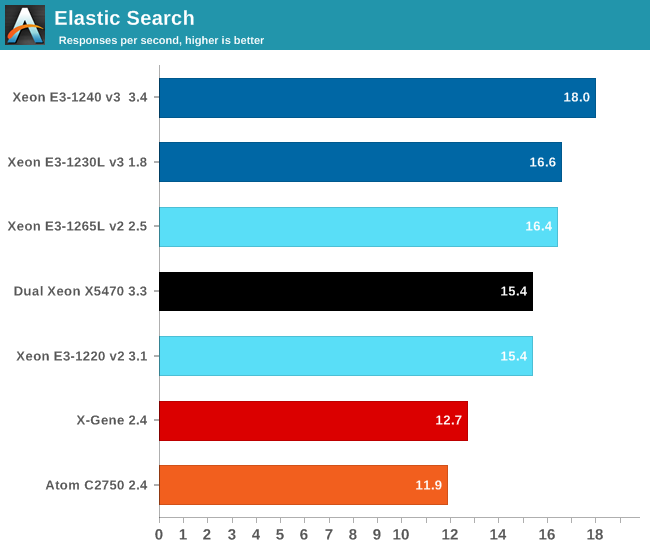X-Gene 1, Atom C2000 and Xeon E3: Exploring the Scale-Out Server World
by Johan De Gelas on March 9, 2015 2:00 PM ESTOur First Scale-Out Big Data Benchmark: Elasticsearch
Elasticsearch is an open source, full text search engine that can be run on a cluster relatively easy. It's basically like an open source version of Google Search that can be deployed in an enterprise. It should be one of the poster children of scale-out software and is one of the representatives of the so called "Big Data" technologies. Thanks to Kirth Lammens, one of the talented researchers at my lab, we have developed a benchmark that searches through all the Wikipedia content (+/- 40GB). Elasticsearch is – like many Big Data technologies – built on Java (we use the 64-bit server version 1.7.0).

For the first time, the X-Gene has a small but measurable (7%) lead over the Atom C2750. Notice that once again the subtle improvements on the Haswell core allow the 25W E3-1230Lv3, typically running at 2.3GHz, to keep up with the 45W Xeon E3-1265L (running at 2.5-3.1GHz).
There is some truth in the claim that SoCs like the Atom C2750 are built for scale-out workloads. While the Atom C2750 achieved only 40% of the Xeon E3's performance running a LAMP stack, it is capable of reaching about two thirds of the performance of a low power Xeon E3. This is nothing earth shattering, but lots of "slim" cores might do a good job in Elasticsearch and other Big Data technologies.










47 Comments
View All Comments
gdansk - Monday, March 9, 2015 - link
xgene is not looking so great. Even if it is 50% more efficient as they promise they'll still be behind Atom.Samus - Monday, March 9, 2015 - link
HP Moonshot chassis are still *drool*Krysto - Monday, March 9, 2015 - link
The main problem with the non-Intel systems is not only that they use older processes compared to Intel, but that they use older processes even compared to the rest of the non-Intel chip industry. AMD is typically always behind 1 process node among non-Intel chip makers. If they'd at least use the cutting edge processes as they become available from non-Intel processes, maybe they'd stand a chance, especially now that the gap in process technologies is shrinking.Samus - Monday, March 9, 2015 - link
AMD simply isn't as bad as people continually make them out to be. Yes, they're "behind" Intel but it's all in the approach. We are talking about two engineering houses that share nothing in common but a cross licensing agreement. AMD has very competitive CPU's to Intel's i5's for nearly half the price, but yes, they use more power (at times 1/3 more.)But facts are facts: AMD is the second high-tech CPU manufacture in the world. Not Qualcomm, not Samsung. It's pretty obvious AMD engineering talent spreads more diversity than anyone other than Intel, and potentially superior to Intel on GPU design (although this has obviously been shifting over the years as Intel hires more "GPU talent.")
AMD in servers is a hard pill to swallow though. If purchasing based on price alone, it can be a compelling alternative, but for rack space or low-energy computing?
Taneli - Tuesday, March 10, 2015 - link
AMD doesn't even make it in top 10 semiconductor companies in sales. Qualcomm is three, Samsung semicondutors six and Intel almost ten times the size of AMD.Outside of the gaming consoles they are being completely overrun by competition.
owan - Tuesday, March 10, 2015 - link
I'm sorry, at one point I was an AMD fanboy, back when they actually deserved it based on their products, but you just sound like an apologist. Facts are the facts, FX processors aren't competitive with i5's in performance or power or performance/$ because they get smacked so hard they can't be cheap enough to make up for it. Their CPU designs are woefully out of date, their APU's are bandwidth starved and use way too much power to be useful in the one place they'd be great (mobile), and their lagging process tech means theres not much better coming on the horizon. I don't want to see them go, but at the rate ARM is eating up general computing share, it won't be long before AMD becomes completely irrelevant. It will be Intel vs. ARM and AMD will be an afterthought.xenol - Wednesday, March 11, 2015 - link
Qualcomm is used in pretty much used in most cell phones in the US to the point you'd think Qualcomm is the only SoC manufacturer. I'm pretty sure that's also how it looks in most of the other markets as Korea. Plus even if their SoCs aren't being used, they're modems are heavily used.If anything, Qualcomm is bigger than AMD. Or rather, Qualcomm is the Intel of the SoC market.
xenol - Wednesday, March 11, 2015 - link
[Response to myself since I can't edit]Qualcomm's next major competitor is Apple. But that's about it.
Also I meant to say other markets except Korea.
CajunArson - Monday, March 9, 2015 - link
Bear in mind that the Atom parts were commercially available in 2013, so they are by no means brand-new technology and the 14nm Atom upgrades will definitely help power efficiency even if raw performance doesn't jump a whole lot.Anandtech is also a bit behind the curve because Intel is about to release Xeon-D (8 Broadwell cores and integrated I/O in a 45 watt TDP, or lower), which is designed for exactly this type of workload and is going to massively improve performance in the low-power envelope sphere:
http://techreport.com/review/27928/intel-xeon-d-br...
SarahKerrigan - Monday, March 9, 2015 - link
14nm server Atom isn't coming.http://www.eetimes.com/document.asp?doc_id=1325955
"Atom will become a consumer only SoC."